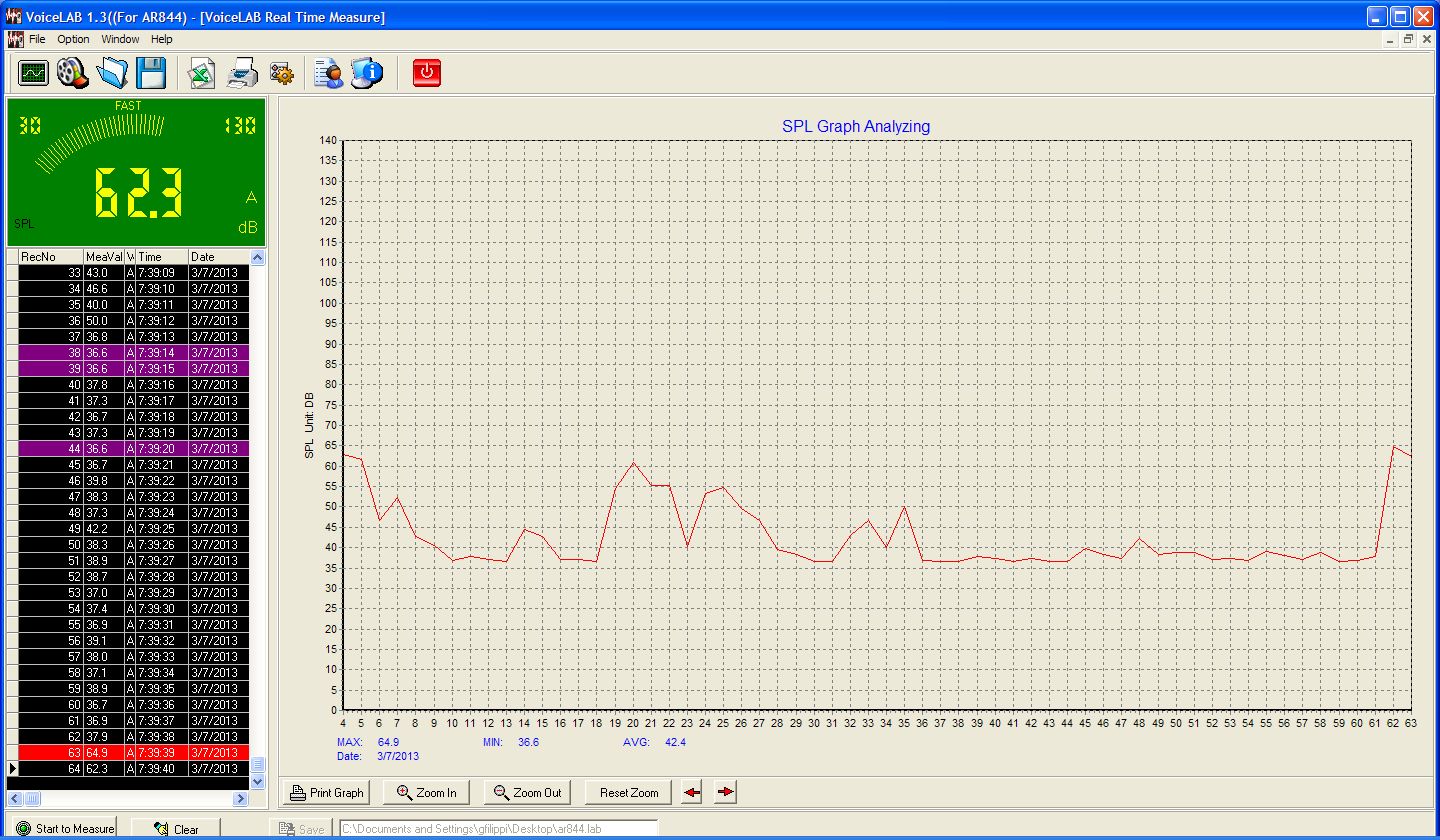Get the right SPL meter
The SPL unit
To make my environmental monitoring station accurate I had to rely on a SPL (sound pressure level) meter.
Building an SPL on my own would have been quite expensive. You need very linear components (microphone, LN amplifier etc. etc.) but you also need a "certified" instruments to eventually compare to.
So I decided to look around for a "off-the-shelf" cheap SPL meter.
Keep in mind professional units are quite expensive, in the range of 0.5K->2K EUR depending on features.
I also wanted to find a meter that had a way to record and store on USB (y original idea was to use a computer as a data logger). After some research I've found a unit from a chinese manifacturer "Smart Labs" marked as AR844 that does fit my needs.
I did found the unit on EBAY for just around 100EUR, and the feature list is just what I need:

- Internal Memory 43.690 slots.
- Clock
- USB connection to store data on a PC and print them
- Measuring scale with curve type 'A' o 'C' with FAST/SLOW sampling period
- Auto range selection (from 30 to 130 dB)
- Analog Output CC (0 - 1.3V, 10mV/dB)
- standard IEC 651 Modello2, ANSI 1.4 Modello 2
- Measuring rage: 30-130 dBA / 35-130dBC
- Resolution: 0.1dB
- Precision: ± 1,5dB
- Sampling period: FAST (125ms), SLOW (1 s)
- Microphone: condenser a elettrete 1/2"
- Overload indicator
- Auto Calibration signal: 94dB at 1kHz (sinusoidal)
- Frequency spectrum: da 31,5Hz a 8,5KHz
- Output CC: 10mV/dB
- Output AC: 0,707 Vrms
Here is the user manual in pdf: AR844.pdf. I can see these units going for 100USD on ebay.com, not bad at all.
AR-844 unit review
The unit does come with a nice yellow box. Inside the box a well padded "pelikan-like" case, the usual heavy duty plastic case you can find at Fry's.


On top of the box you can see in yellow the "SmartSensor" company logo, and (in golden letters "IntelliInstruments Plus". Inside the case you will find:
- a small user manual,
- an RCA jack (3.5mm) for ac/dc output reading
- a small CD with drivers and software (windows XP 32bit ONLY!! :-(
- USB cable (1mt long more or less)
- You'll find also 6 type AA alkaline batteries
- a wind/pop shield for the microphone.
Here is the unit itself sitting in front of my window:
 I have to say the LCD display is quite good. It does display the reading in big numbers with a progress bar on the top.
I have to say the LCD display is quite good. It does display the reading in big numbers with a progress bar on the top.
Buttons are clear and responsive. A central ON/OFF button, two left right buttons to select the scale and two buttons to select the curve type (A/C) and the sampling time.
On the bottom part of the unit (not visible in my picture) you will find the USB connector, an input for an external DC power supply and the output for external AC/DC value reading.
The unit can store samples in the internal memory too, and you'll be able to download and plot the data using the provided software.
And this is for the "good" stuff ... On the "not so good" ... the provided software is a Windows ONLY 32bit.
The provided USB drivers will install just fine, but the software provided sometime does not install for some windows library conflict and it's quite annoying (I still have to understand the issue ... no time to debug)
This unit will run on batteries just fine. Actually if you plug the USB cable you won't need batteries at all, and this was a happy surprise because it made my setup even more simple: the RaspberryPi usb port will power the SPL meter directly ;-)
VoiceLab Software
Once you have installed the USB drivers you can also install the provided software. It is a "customized" version of VoiceLab.
Run the software and you will have a very intuitive UI. On the left a "mirror" of the instrument LCD and on the right a self updating plot of the measure realtime. Many other features are available: you can download and plot data previously stored in the unit, or print them in .pdf or export them in .xls format.

Overall the software it's easy to use and quite simple, the only proble is that it works only on windows XP (32bit) and somtimes it does not install correclty.
I wish the USB protocol of this instrument was documented in the manual itself, it would make it a lot easier to connect the AR844 unit under other OS (my target is Linux) without reverse enginering..
Oh well ... it means we need to do some investigation, isn't it?
